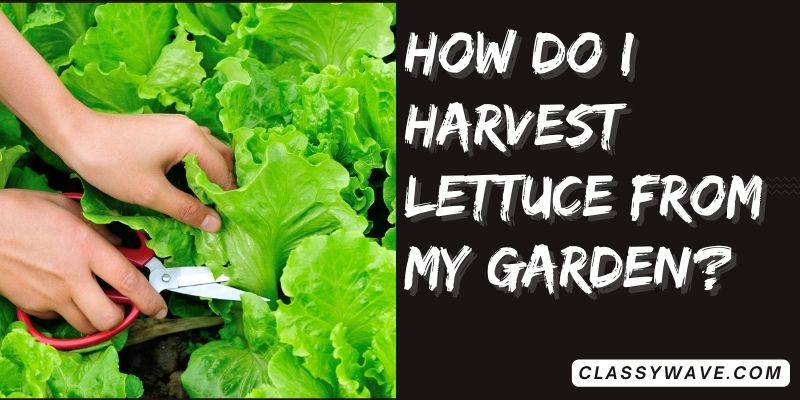How do I harvest lettuce from my garden? A Beginner’s Guide
Embarking on a journey to harvest lettuce from your garden involves mastering diverse aspects, from the optimal timing for picking to specialized techniques like hydroponic harvesting. Navigate through creative recipes, companion planting wisdom, market-oriented tips, and the delightful world of lettuce microgreens for a comprehensive understanding of this versatile crop.
Timing Your Lettuce Harvest
Harvest lettuce when leaves are young and tender, avoiding bitterness that develops with maturity. In general, pick loose-leaf varieties as soon as leaves reach a desirable size while heading varieties can be harvested when the heads are firm.
Harvesting Different Lettuce Varieties
Various lettuce types require specific harvesting techniques. Cut loose-leaf varieties near the base, allowing regrowth. Harvest heading lettuce by cutting the entire head at the base when mature. Snip individual leaves from Romaine and Butterhead types as needed.
Essential Tools for Lettuce Harvest
Equip yourself with sharp scissors or garden shears for clean cuts. Harvesting baskets or containers prevent bruising. A kneeling pad offers comfort during prolonged harvesting sessions, ensuring efficiency and care for your lettuce crop.
Gentle Lettuce Harvesting Techniques
Employ gentle hands and sharp tools to avoid damaging lettuce leaves. Hold the base of the leaf or head while cutting to minimize stress on the plant. Smooth, damage-free harvesting preserves the quality and appearance of your lettuce.
Storing and Preserving Fresh Lettuce
After harvest, store lettuce in the refrigerator to maintain freshness. Remove excess moisture by patting leaves dry before storage. For longer preservation, consider vacuum-sealing or storing in airtight containers with a paper towel to absorb moisture.
Maximizing Continuous Lettuce Harvest
Extend your harvest by adopting a cut-and-come-again approach. Harvest outer leaves regularly, allowing the inner leaves to continue growing. This method ensures a continuous supply of fresh lettuce throughout the growing season.
Troubleshooting Lettuce Harvest Issues
Address common harvesting challenges such as bolting, bitterness, or uneven growth. Adjust planting times, choose appropriate varieties, and manage environmental conditions to overcome issues and optimize your lettuce harvest.
Saving Seeds: Harvesting Lettuce for Seeds
If seed-saving is a goal, allow some lettuce plants to bolt and flower. Harvest the seed heads when they turn brown and dry. Gently collect seeds, remove debris, and store them in a cool, dry place for future planting.
Optimal Flavor: Harvesting Lettuce at Peak
Capture the best flavor and texture by harvesting lettuce at its peak. Taste preferences vary, but generally, lettuce is most flavorful just before it reaches full maturity. Experiment with timing to find the flavor profile you prefer.
Community Lettuce Harvest Workshops
Collaborate with your community in hands-on lettuce harvesting workshops. Share knowledge on timing, techniques, and post-harvest care. These workshops foster a sense of community and encourage sustainable gardening practices among participants.
Hydroponic Lettuce Harvesting
Explore the nuances of harvesting lettuce in hydroponic systems, emphasizing nutrient-rich water solutions. Learn efficient techniques for soilless cultivation, ensuring optimal growth and quality produce without traditional soil-based methods.
Creative Lettuce Recipes
Elevate your lettuce harvest by discovering creative recipes that showcase its versatility. From vibrant salads to innovative wraps, explore culinary delights that transform your fresh lettuce into delicious and nutritious meals.
Lettuce Companion Planting
Uncover the benefits of companion planting with lettuce to enhance overall garden productivity. Discover compatible plant pairings that deter pests, encourage beneficial insects, and promote healthier growth for both lettuce and neighboring crops.
Lettuce Harvesting for Market
Delve into strategies for harvesting lettuce destined for market sale. Learn presentation tips, including proper packaging and handling, to ensure high-quality, visually appealing produce that meets market standards and attracts customers.
Lettuce Microgreens
Explore the world of lettuce microgreens, harvesting these miniature greens known for their intense flavors and nutritional benefits. Learn the ideal harvesting stage and techniques to enjoy these tiny delights in salads, sandwiches, or as a garnish.
Conclusion
In conclusion, harvesting lettuce from your garden can be a rewarding and diverse experience. From mastering traditional soil-based methods to exploring hydroponic systems, creative culinary applications, and market-focused strategies, this guide equips you with knowledge to maximize the yield and enjoyment of your lettuce harvest. Whether you’re a seasoned gardener or a newcomer, these insights ensure a successful and fulfilling lettuce harvesting journey.
FAQs
Question: When is the best time to harvest lettuce for optimal taste and texture?
Answer: Harvest when leaves are young and tender, just before reaching full maturity for peak flavor.
Question: How do I store freshly harvested lettuce to maintain its crispness?
Answer: Pat leaves dry, refrigerate in airtight containers, and consider vacuum-sealing or using a paper towel to absorb moisture.
Question: Can I harvest lettuce for seeds, and how do I go about it?
Answer: Allow some plants to bolt, harvest seed heads when brown and dry, then store seeds in a cool, dry place.
Question: What companion plants work well with lettuce for a healthier garden?
Answer: Plant lettuce alongside carrots, radishes, and herbs like dill and chamomile to deter pests and enhance growth.
Question: What are effective methods for continuous lettuce harvesting in a home garden?
Answer: Adopt a cut-and-come-again approach, harvesting outer leaves regularly to promote continuous growth and a sustained harvest.







